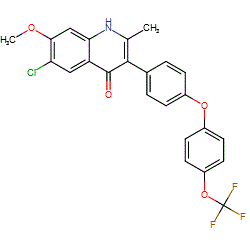|
Synonyms: ELQ300
Compound class:
Synthetic organic
Comment: ELQ-300 is a late lead candidate from a novel class of 4(1H)-quinolone-based compounds with potent antimalarial activity [4]. The ELQs (endochin-like quinolones) are structural derivatives of endochin (PubChem CID 100474), which has potent antiplasmodial activity, but is highly metabolically unstable in mammals [1,6].
The Malaria tab on this ligand page provides additional curator comments of relevance to the Guide to MALARIA PHARMACOLOGY. Ligand Activity Visualisation ChartsThese are box plot that provide a unique visualisation, summarising all the activity data for a ligand taken from ChEMBL and GtoPdb across multiple targets and species. Click on a plot to see the median, interquartile range, low and high data points. A value of zero indicates that no data are available. A separate chart is created for each target, and where possible the algorithm tries to merge ChEMBL and GtoPdb targets by matching them on name and UniProt accession, for each available species. However, please note that inconsistency in naming of targets may lead to data for the same target being reported across multiple charts. ✖ |
|
|||||||||||||||||||||||||||||||||||
| Bioactivity Comments |
| The interaction table below provides data from whole cell assays and gives the antiparasite activity of ELQ-300 against a number of Plasmodium lifecycle stages. The results include an evaluation of asexual blood stage activity using a panel of P. falciparum strains, with ELQ-300 demonstrating no evidence of reduced potency against drug-resistant strains. In addition, ex vivo testing of drug-resistant field isolates of the two most significant human malaria species, P. falciparum and P. vivax, were found to be sensitive to ELQ-300 (EC50 values 14.9 and 17.9 nM respectively) [4]. ELQ-300 is not cytotoxic vs. various mammalian cell lines which is indicative of an excellent in vitro selectivity index, nor does it inhibit ATP production in mammalian cells lines or from the human cytochrome bc1 complex isolated from HEK293 cells. |
| Whole organism assay data | |||||||||||||||||||||||||||||||||||||||||||||||||||||||||||||||||||||||||||||||||||||||||||||||||||||||||||||||||||||||||||||||||||||||||||||||||||||||||||||||||||||||||||||||||||||||||||||||||||||||||||||||||||||||||||||
| Key to terms and symbols | Click on species/strain names for details | Click column headers to sort | |||||||||||||||||||||||||||||||||||||||||||||||||||||||||||||||||||||||||||||||||||||||||||||||||||||||||||||||||||||||||||||||||||||||||||||||||||||||||||||||||||||||||||||||||||||||||||||||||||||||||||||||||||||||||||
|
|||||||||||||||||||||||||||||||||||||||||||||||||||||||||||||||||||||||||||||||||||||||||||||||||||||||||||||||||||||||||||||||||||||||||||||||||||||||||||||||||||||||||||||||||||||||||||||||||||||||||||||||||||||||||||||








